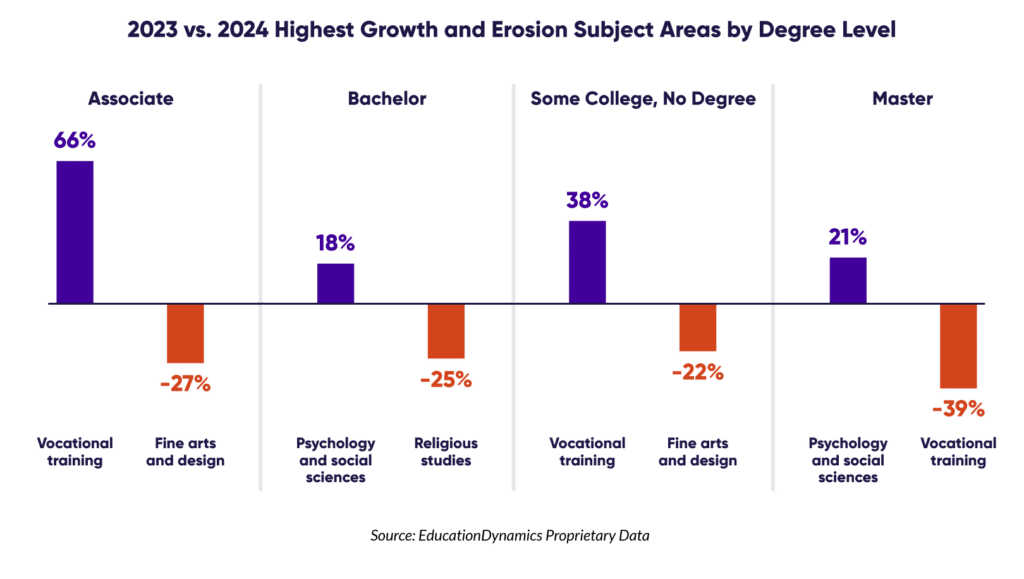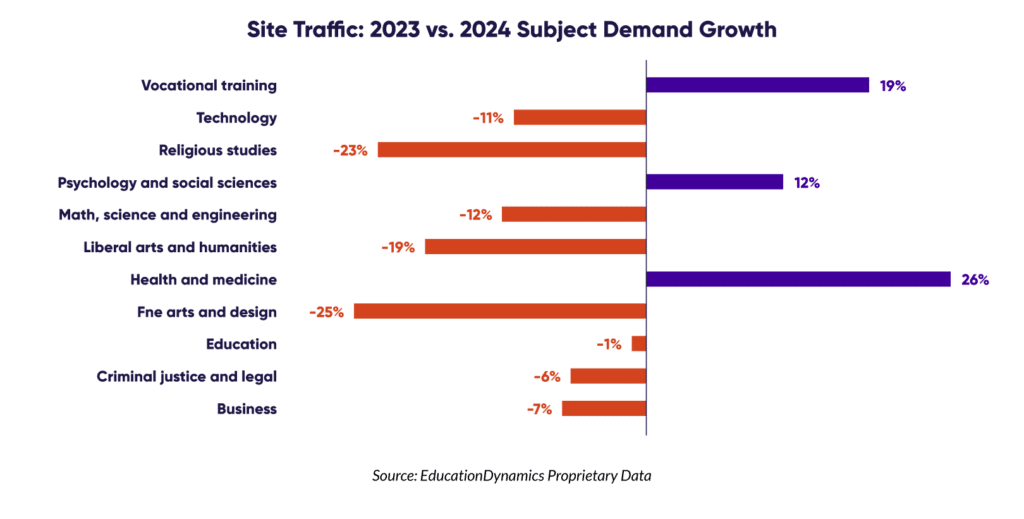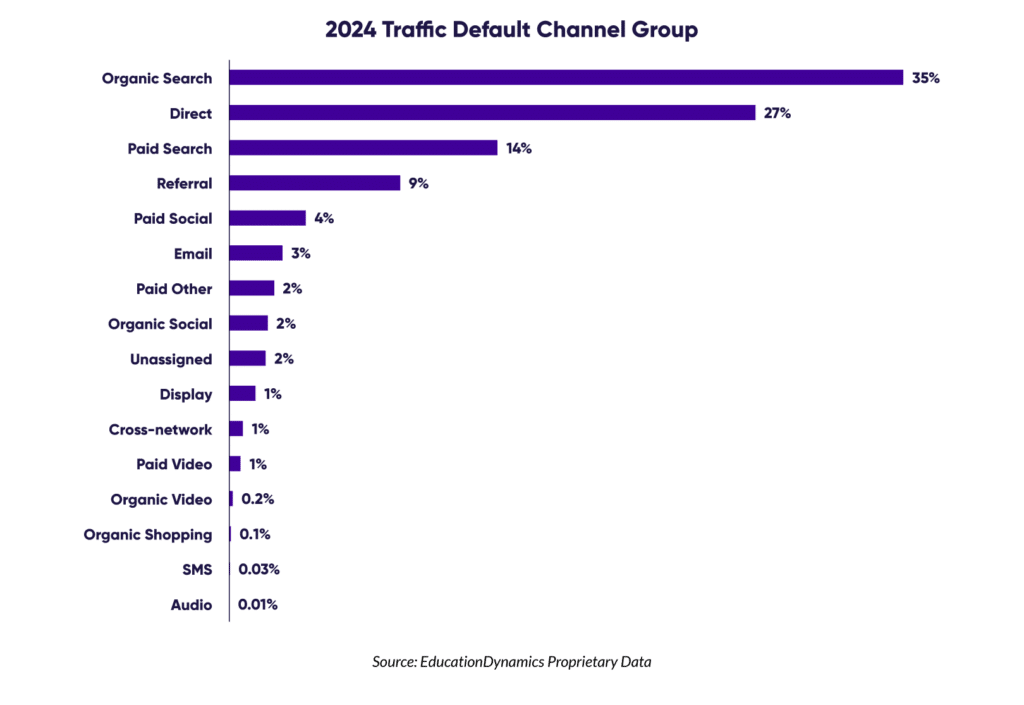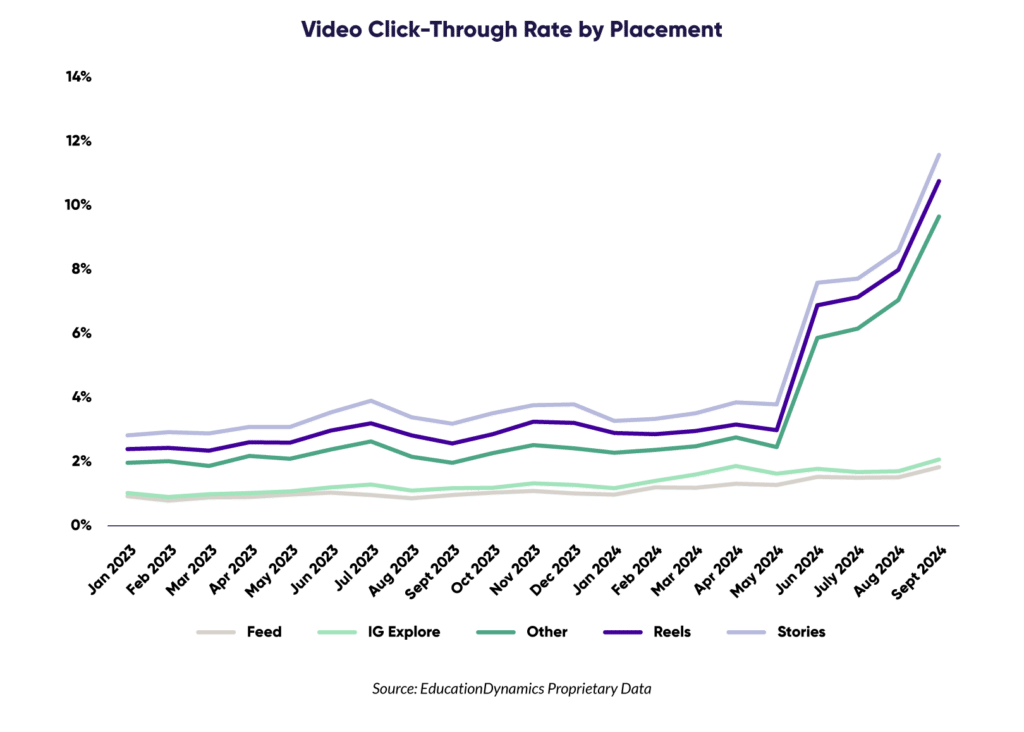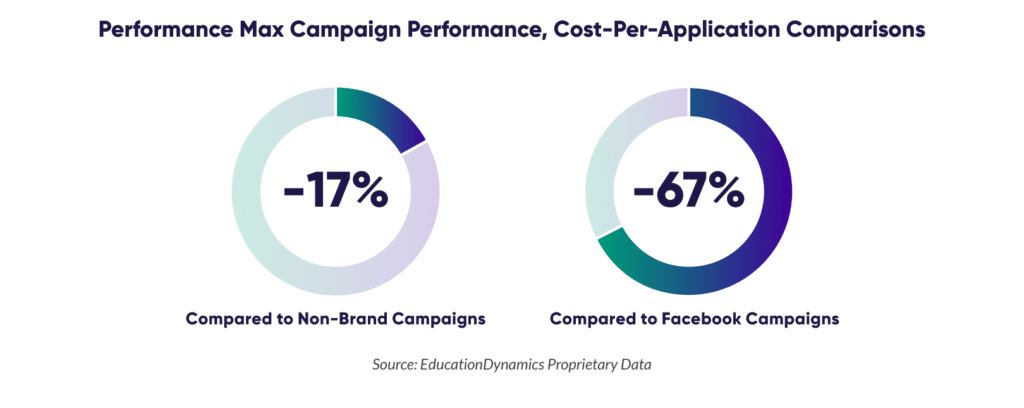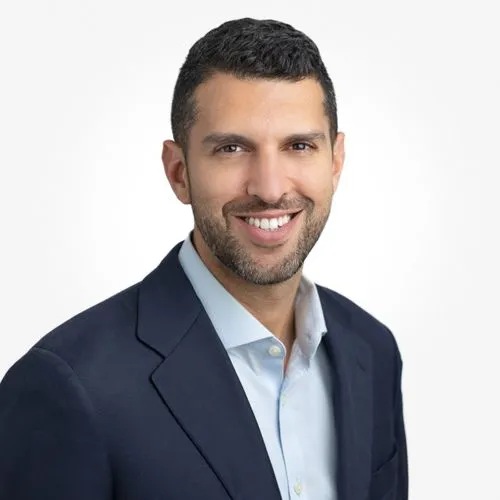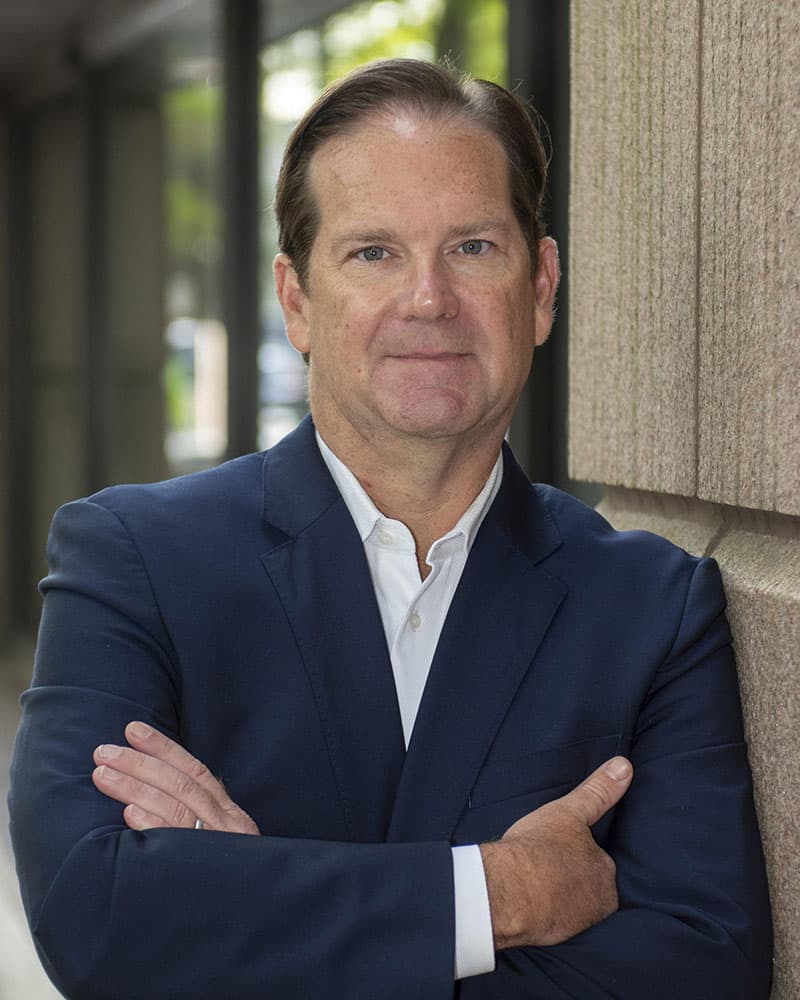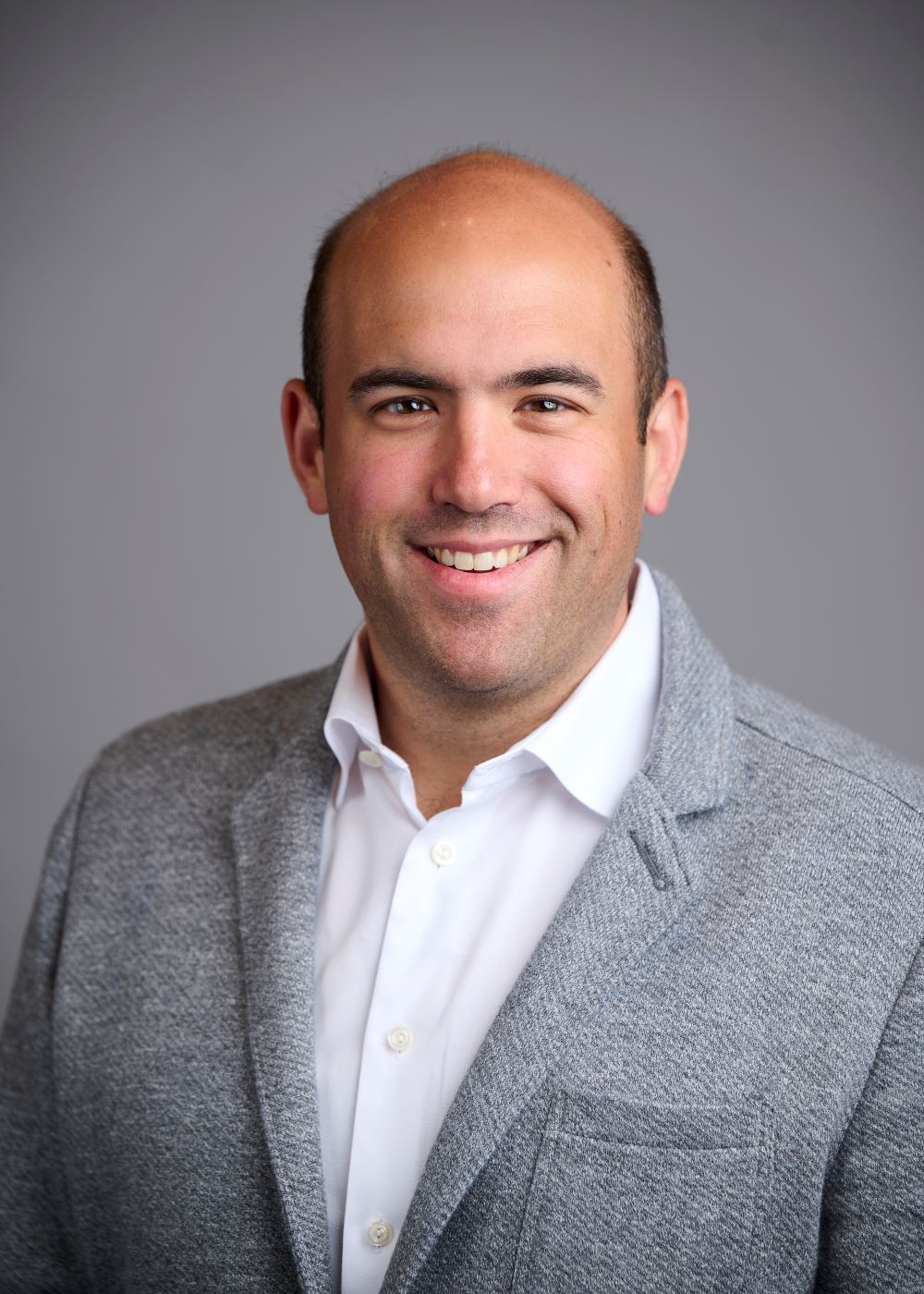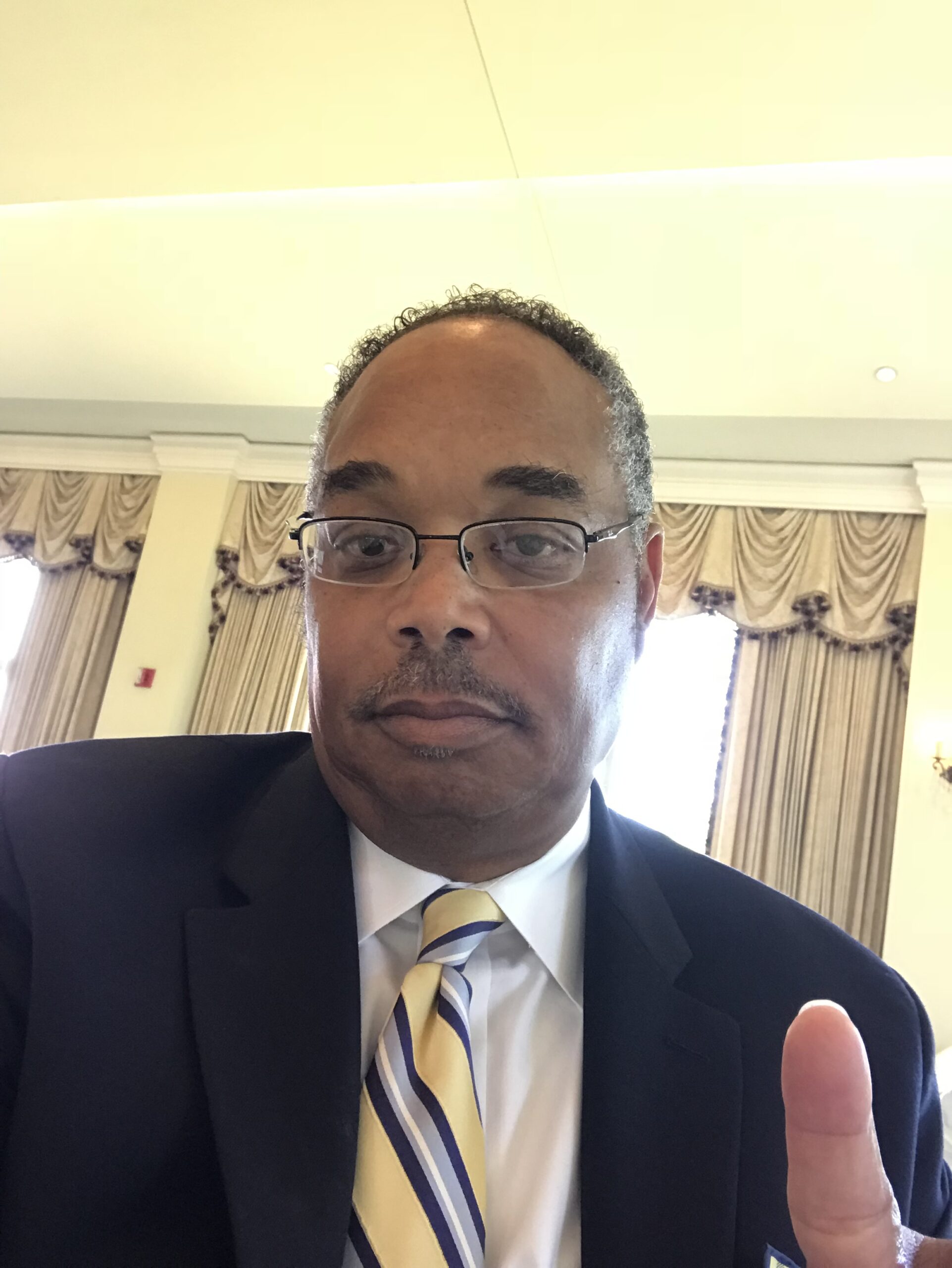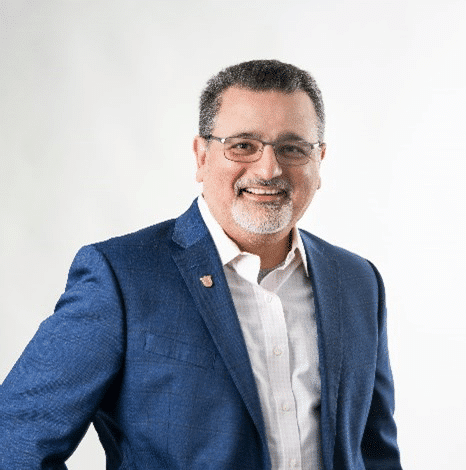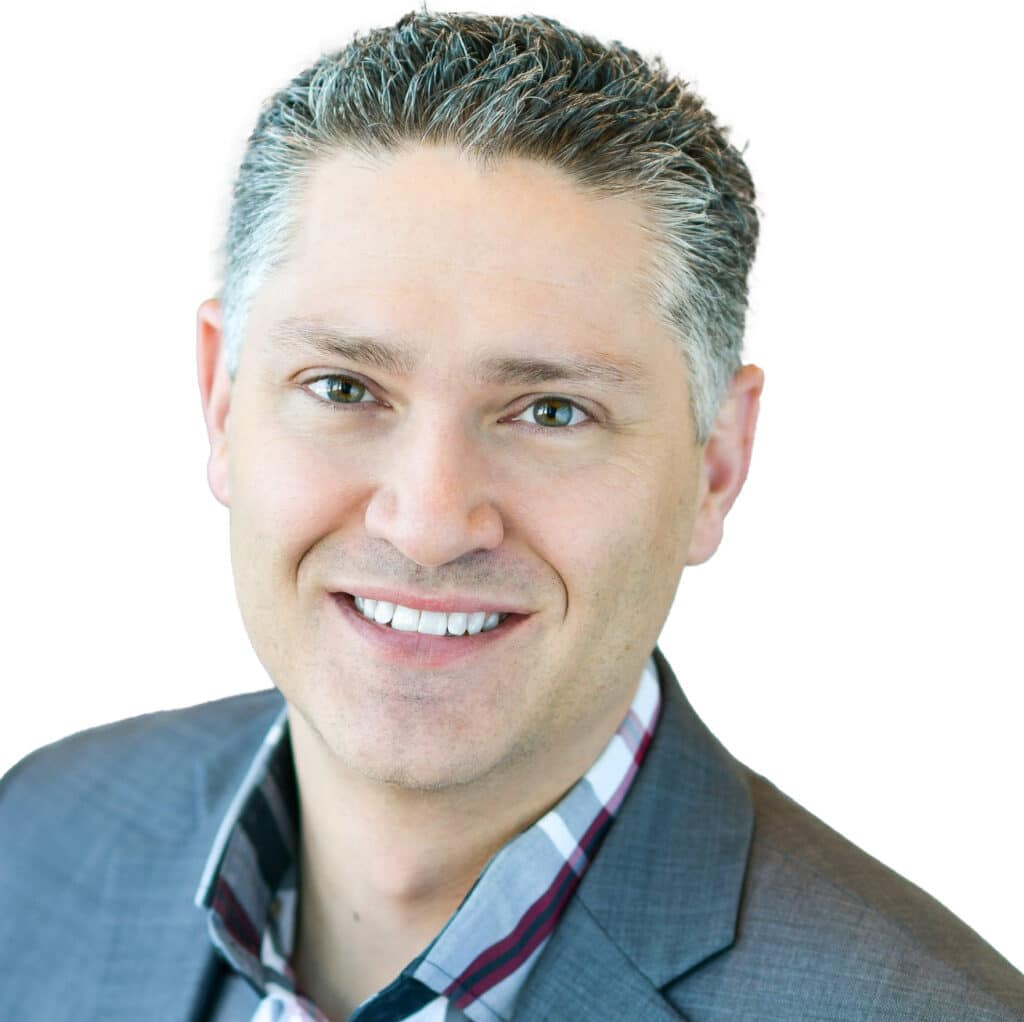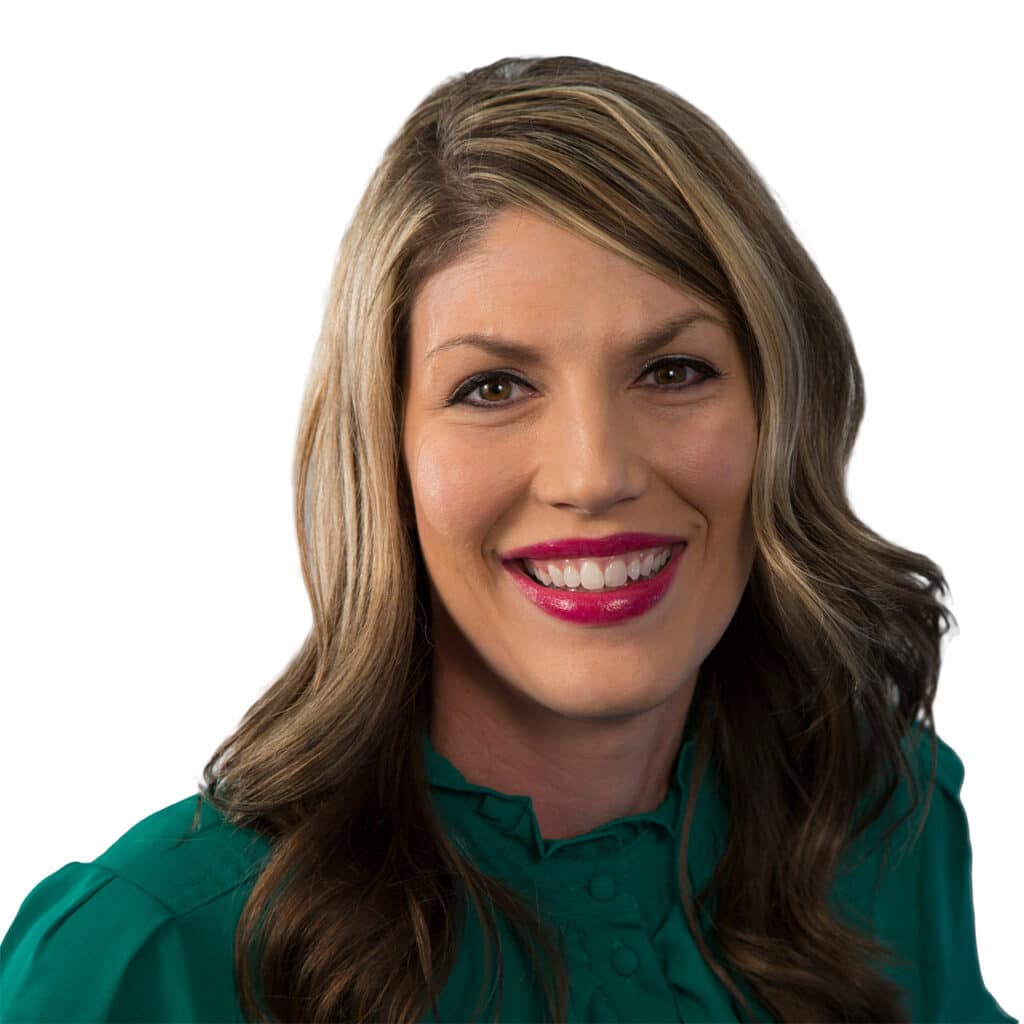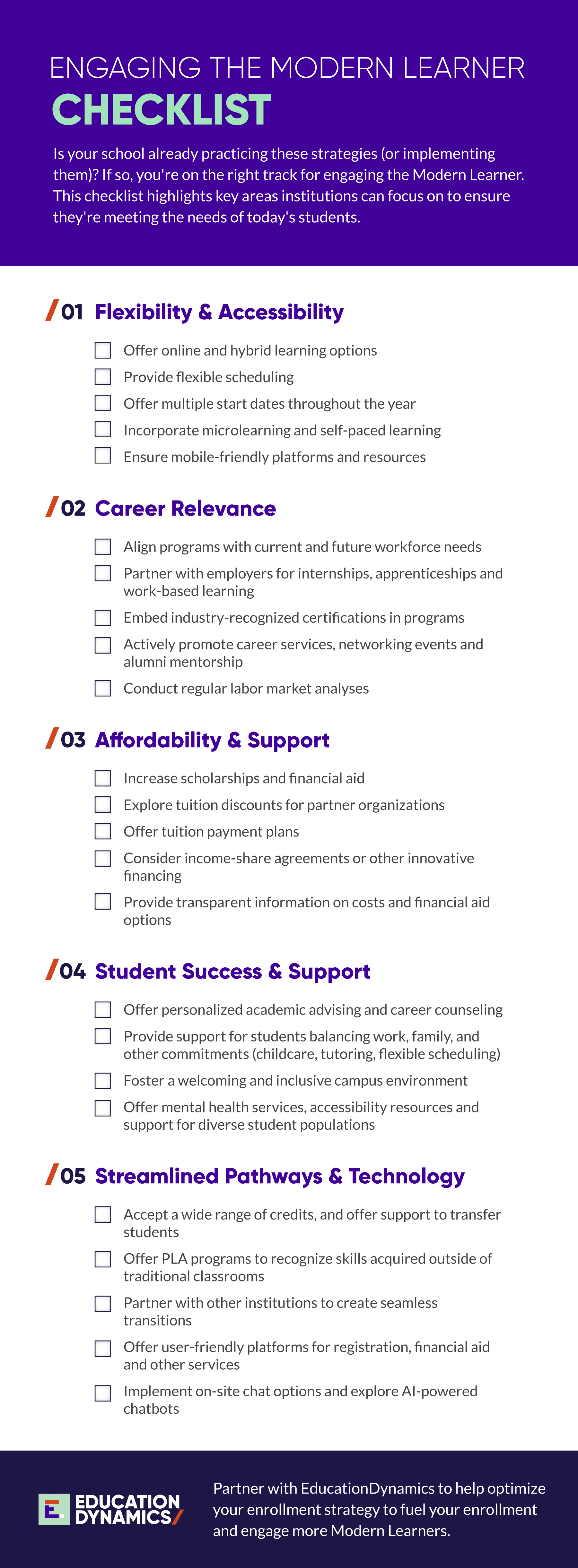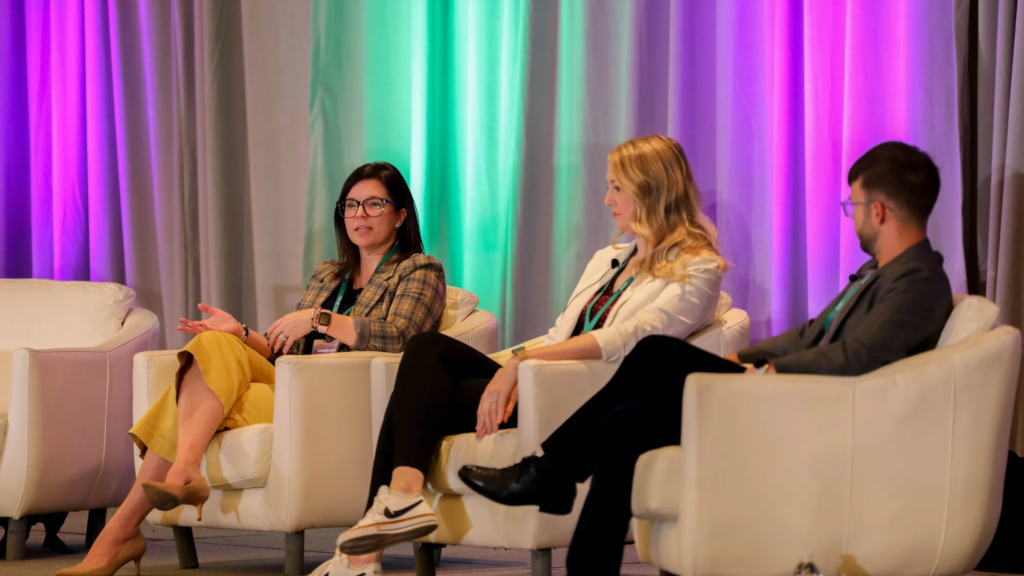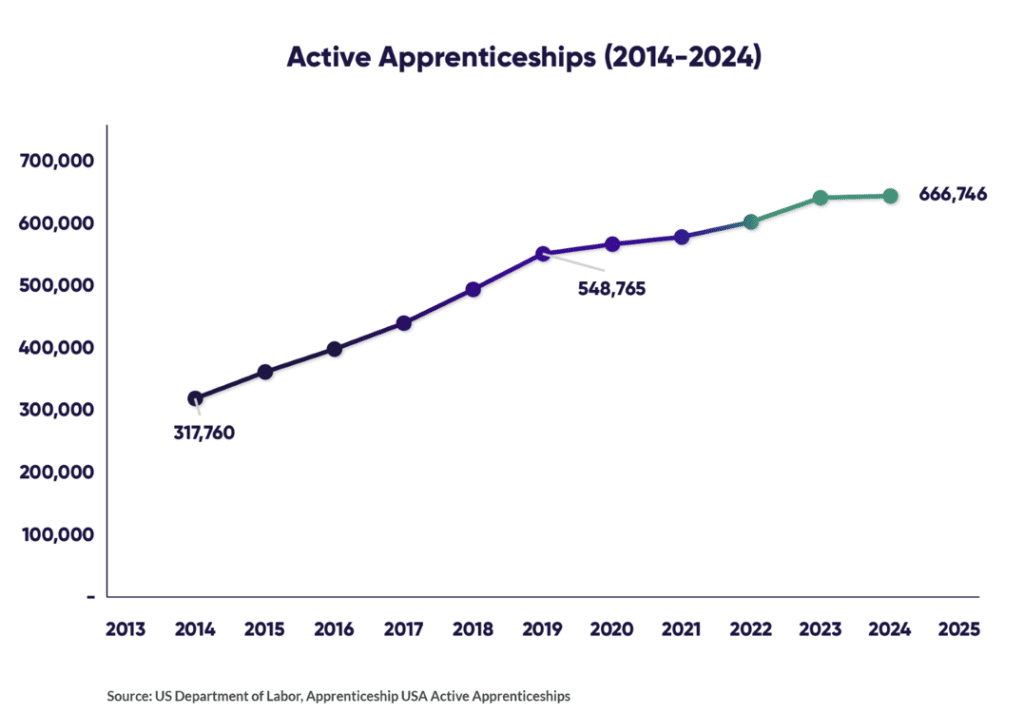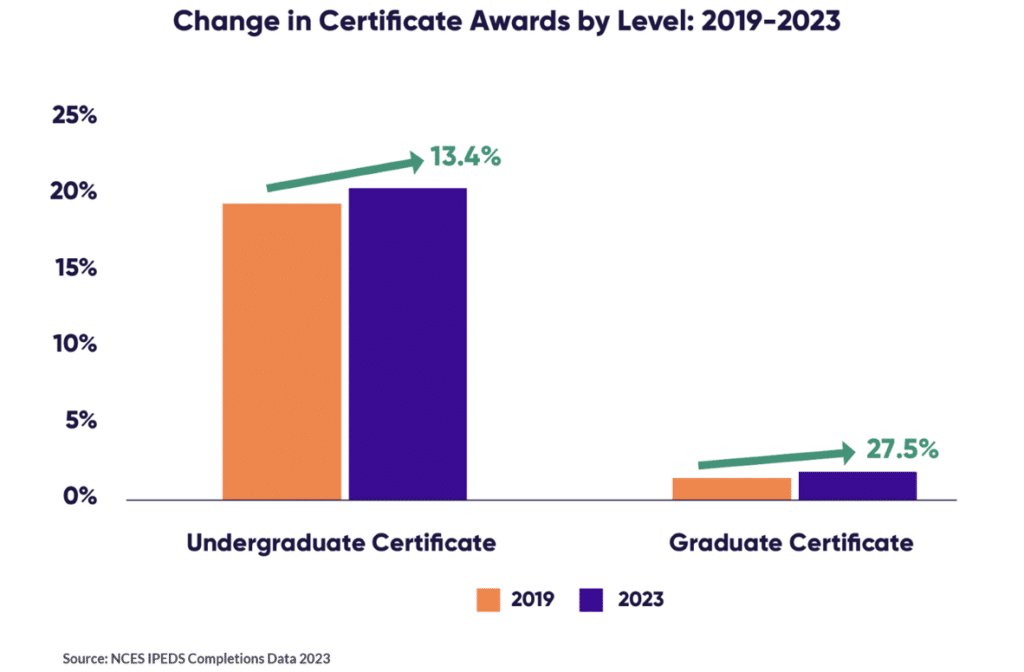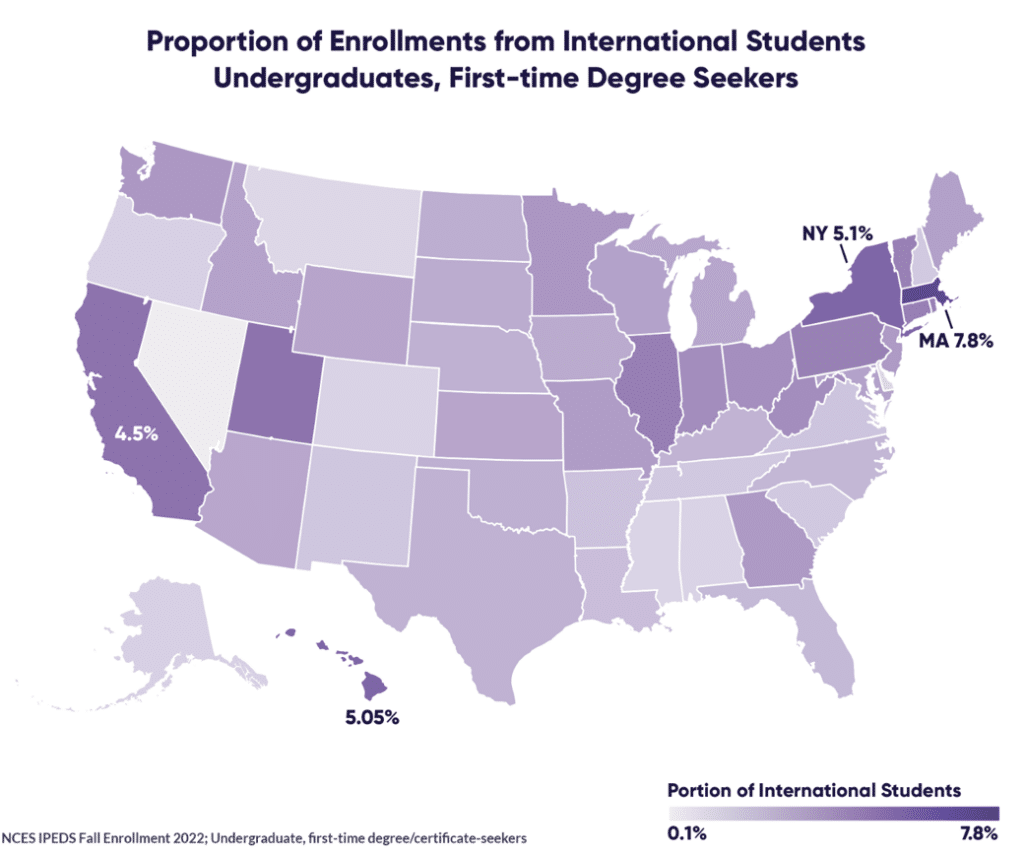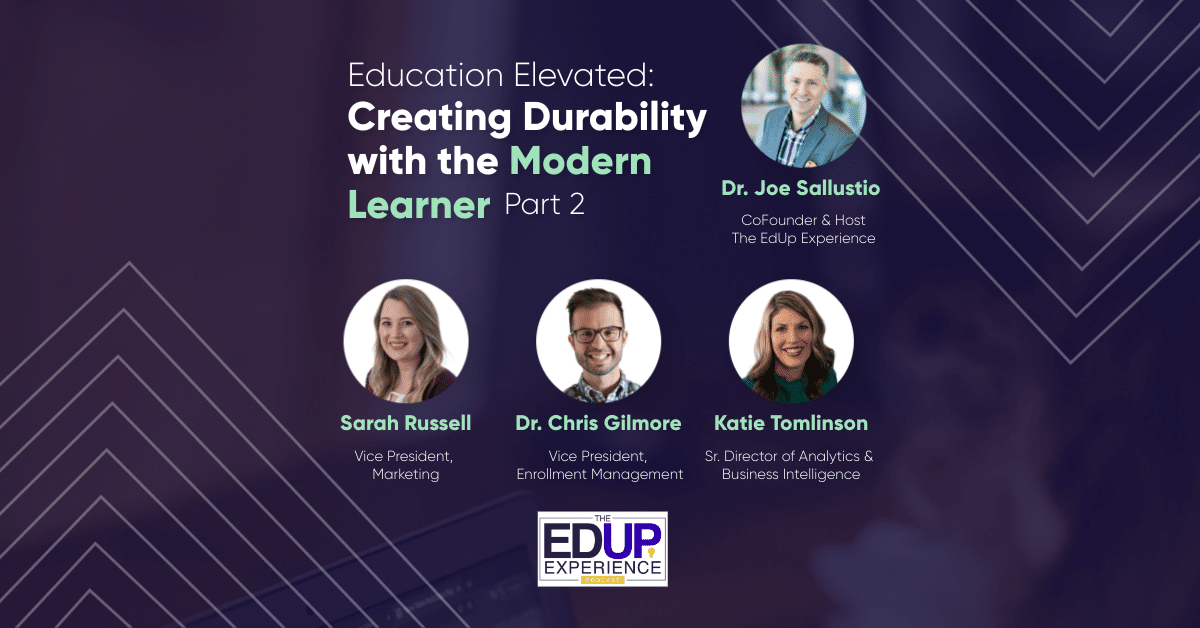Transcript
Dr. Joe Sallustio:
Welcome back everybody. It’s your time to “EdUp” on the EdUp Experience Podcast where we make education your business. This is episode two of a special miniseries titled “Education Elevated: Navigating the Future of Online Higher Education,” brought to you by the EdUp experience and our amazing partner EducationDynamics, who’s going to supply all of the brainpower today. I don’t actually have to do anything because they’ve got all the answers to your most pressing questions about today’s Modern Learner. So this series is really important because we’re going to explore the evolution, really the landscape of higher education as experienced by today’s diverse and interconnected student population. And I think what it comes down to is students today, however you define that, and I think it is important to define that student– an 18 year old, 88-year-old, somewhere in between, transfer credit, no transfer credit, first time full-time, freshmen, adult student, right?
Dr. Joe Sallustio:
There’s so much definition that goes around the word student, and I think we fail in higher ed a lot of times to say exactly who we’re talking about. So this concept of the Modern Learner really has been something, and I’ve been championing here on the podcast and I got it from EducationDynamics. They came up with it and I was like, “Ooh, that’s good. I think I’ll steal that a little bit, but also give credit where it’s due.” And I always tag the group and I tag ’em and I give the call out. But the Modern Learner really speaks to, I think today’s student with evolved behaviors, the way they look at things, the way they make decisions. And so EducationDynamics has brought us a panel of experts today, a panel of the most knowledgeable people in enrollment and marketing that you can find anywhere. And I know this because I know them and I’ve talked to them before, and the insights that you can get from them are going to be incredible and let’s get them here on the mic one at a time. Ladies and gentlemen, first off, she’s Sarah Russell. She’s the Vice President of Marketing with EducationDynamics. How are you, Sarah?
Sarah Russell:
I’m doing great. How are you?
Dr. Joe Sallustio:
Back again, right? I think this is the 2nd or third time you’ve been on with me.
Sarah Russell:
At least the second that I can remember,
Dr. Joe Sallustio:
But really important now as we talk about the Modern Learner, and we’re going to get to it because marketing obviously is a huge part of how you got to get to these folks first and their behaviors are a little bit different, and then you’ve got to figure out how to enroll them. Also, we’ve got Chris Gilmore with us today. He’s the Vice President of Enrollment Marketing with EducationDynamics. Chris, welcome back. How are you?
Dr. Chris Gilmore:
Yeah, I’m great, Joe. Thanks for having me.
Dr. Joe Sallustio:
And then you know what, Chris, once you find the Modern Learner and you figure out how to speak to them and you get them enrolled, which is not easy, right? It takes a specific amount of knowledge and it’s not the same as enrolling what we would call a traditional student. It’s a completely different, you got to track and you got to have analytics and you got to data. And so we brought a data expert. She’s Katie Tomlinson, she’s director of Analytics with EducationDynamics. Katie, welcome back. How are you?
Katie Tomlinson:
Great. Thank you for having us join.
Dr. Joe Sallustio:
So you guys are all back. We’re going to talk about the Modern Learner. This is so important and it’s really an honor for us to partner with EducationDynamics as we talk about the Modern Learner. And Katie, I want to start with you. Who is the Modern Learner? Seems like we need some definition around who the Modern Learner is. So let’s start there and any kind of stats or demographics, of course, you’re the Director of Analytics, so I have to ask you to bring the meat and potatoes, so to speak, any data you have around how you define the Modern Learner.
Katie Tomlinson:
Thanks, Joe. So the Modern Learner can really be anyone. We’re talking about working adults, we’re talking about parents, veterans, lifelong learners who are juggling those multiple responsibilities while still pursuing their education. The Modern Learner also includes our younger recent high school graduates. So those on that path between high school to college graduation. And what we’re seeing is that the lines are really being blurred between what we used to define as adults and traditional students as both their educational and their student preferences are evolving. And we need to rethink our assumptions about who these students are based on both their age or their background. My point here is that age really no longer predicts modality or pathway, which makes it extremely important as you move forward that your brand and your messaging strategy and your approach needs to be unified across your entire organization. We should not be parsing out different strategies based on perspective students age or their modality anymore.
Dr. Joe Sallustio:
So we think kind of in a binary way in higher education, we say there’s traditional students who go to when we think that, or you talk to somebody who lives outside of higher education who has kids that attend an institution and you say higher education to them. They think red brick buildings, students walking on campus with a backpack, right? Traditional students. That’s what I think so many people envision. And then everybody else who’s the non-traditional student, the adult student, maybe the student who’s working, blah, blah, blah, blah, blah. What I hear you saying is the Modern Learner isn’t the modality, it’s not the way in which you journey through your educational pursuits. It’s characteristic based rather than modality based, right?
Katie Tomlinson:
That’s correct. Yeah. I mean, even if you think about the number of higher education students participating in online starting in 2019, that number was 33%. We’re now at that staggering 66%. So if you are thinking about describing that Modern Learner and those attributes, we really need to think about them having some of those same motivations and behaviors that we used to coin with that traditional online college student.
Dr. Joe Sallustio:
That’s so good. And Chris and Sarah, I’m bringing you both in here. This is, I say I’m going to ask certain questions and then I actually get on here and I go, “I’m going to take a detour.” I have talked to over 300 college presidents. More than that, probably 320 that with what we have in the can. One of the most, I want to say it’s common, but it comes up is okay, there’s some traditional campuses, and when I say traditional, they’re on a traditional academic calendar, fall, spring, little bit of summer, fall, spring, little bit of summer, kind of like that. And you go, okay, how are you going to differentiate? What are you going to do in the future? How are you going to sustain your enrollment? Well, we’re going to bring in an adult student. We’re going to go after a Modern Learner. We’re going to bring in this different type of student than we’ve ever been used to before, and we’re going to do it.
Dr. Joe Sallustio:
We’re just going to say, we’re going to go after this student and we’re going to bring them in on our traditional academic calendar with our classes that aren’t designed typically for adult learners or for the modern student. And I think that maybe there’s this expectation that just because you’re offering something online, magic happens and people start showing up in your classes, but it’s totally different infrastructure, thought processes, messaging, enrollment. Can you guys weigh in a little bit on some of the differences? I mean, you can’t just do it, right? You can’t just go, “We’re going to go after some college know credential population” and the magic takes place.
Dr. Chris Gilmore:
Maybe Sarah, you can start speaking to how we attract them in the first place, because even starting at that is a different game. And then I can talk a little bit to once we actually have them in the funnel.
Sarah Russell:
Yes, absolutely. So from a marketing standpoint, it’s really important that you understand the media habits and usage of this population and where you can reach them and at what stage of their decision journey they are typically in when they’re interacting with certain points of media. So generally, if you’re going to want to get in that consideration stage, you need to do it early because once they narrow their set of prospective colleges down to two or three, if you’re not in that grouping, you’re already too late. And if you’re focusing really heavily on the bottom of the marketing funnel with a lot of lead gen, but you haven’t gotten in that consideration list yet, you’re really wasting your dollars there. So making sure that you are allocating enough of your budget to inform that upper funnel awareness and consideration, and that’s going to allow you to really heavily play in connected TV, a lot of the reels and short form video in social, et cetera.
Sarah Russell:
And you should really have a strong messaging pipeline for how are you speaking to those students at the top of the funnel, How are you speaking to them throughout the funnel and how does their mindset change and what becomes important to them. Going back to school is a very big decision, no matter the student population. So whether that is a first time freshman going to school for the first time or an adult student who may be returning to school or finishing a degree, you really have to make sure that you are addressing their pain points with marketing because today’s Modern Learner is a very well-informed and highly researched student. So they’re going to want a lot of that information on the front end before they even consider your school as being in their prospect list. So really understanding those media channels, the messaging that’s going to resonate throughout. So then once they get to the point of raising their hand, requesting information, interacting with your institution, they’re a lot more informed than maybe they were 2, 3, 5 years ago,
Dr. Joe Sallustio:
Chris. Okay. So you’ve done all of this different that Sarah made it sound relatively easy –it is not– everything she said is super hard. You have to have a completely different infrastructure thought process. Even your technology has to be upgraded in different. So let’s just say you’re skilled enough to do some of the things that Sarah says in terms of marketing, which many schools are not.
Dr. Chris Gilmore:
Yeah, absolutely right. I mean, I agree with everything that Sarah said in terms of how we’re attracting them, how we’re engaging them, how we’re getting them into the funnel, and then a different workflow starts and that’s how we’re communicating with them. As Sarah said, we need to be making sure that we are in the channels that they’re in. That applies also once we get them into the funnel. So really flexible contact strategies are really important. With the Modern Learner, we can’t tell them how to communicate with us. We should be so lucky that they are choosing to engage in communicating with us. So we have to really be present wherever the student is comfortable engaging. So text messaging, email, phone call, if that works for them, but being present in multiple channels during the initial contact strategy. And then once you engage the student, it is a little bit of a different flavor to the conversation.
Dr. Chris Gilmore:
Both Katie and Sarah laid out that these students are primarily motivated by outcomes, career opportunities, job growth, compensation and salary potential. So to Sarah’s point, they’re doing a lot of research before they even enter that funnel. And when they do get to the funnel and they connect with your enrollment professionals, your enrollment counselors, your coaches, they’re likely to come with very specific questions. And those are likely to be amongst others, very outcome-based. So your team needs to be able highlight the value propositions of the programs, which means that your programs need to be aligned with a good outcomes-based value proposition because if it’s not, they’re not going to be attracted to it in the first place. If it is and we cannot articulate it, well then same thing, it gets a little blurry and not mid funnel. So I think being present in the channels that they’re willing to engage with you on, and then once we do get them engaged, being able to speak specifically to the needs of this population, understanding that it’s a little bit different than your straight out of high school population.
Dr. Joe Sallustio:
Do you think, Chris, that students, the Modern Learner is patient, are they willing to wait? And I ask this, let me give you the context. I’m on a fall spring calendar, right? My term is August. In January, I enroll a student in November or October and I say, “Hey, look, you missed fall. You got to wait till January or February.” Are they waiting around? Is brand so strong that they’re waiting around or are they going, you know what, “I’m ready when I’m ready and I’m going to find a school that’s ready for me.”
Dr. Chris Gilmore:
It is a big risk. You’re taking some might and it depends on the availability of the program and what really drew them to them, but more than likely they have alternative options to complete it and they’re going to find a way to get in faster. And to Sarah’s point, again, a lot of these students are doing research before they engage. A lot of this decision making is a little further on than we’re used to historically. So by the time they’re speaking with you, by the time you’re advising them on the application process, they’re ready to roll. And so we as institutions want to capitalize on that, but they primarily as students, they are ready for this step by the time they take that. So when you get them through that application process and then you tell them, “Hey, term starts in 12 weeks,” it’s not good. If they can find a way to start it in two weeks, they’re probably going to be motivated to do that.
Dr. Joe Sallustio:
Sarah, you back that up from your perspective and what you’ve seen that students are, I find the Modern Learner to be pretty impatient and rightfully so. It could be that they have tuition reimbursement or something and they go, I want to start right now. And you think about a student who comes back. A lot of these, some college degree students or no credential students, they’ve literally gone through the mental thought process of I want to go back. And then somebody says, well, you can’t start right now. Right? Then it’s done. It’s like the psychological contract that I was about to have with you is broken. And so it’s like Amazon telling you that your item is on back order for three weeks. You either order it something else or you go somewhere else to order it.
Sarah Russell:
Yes, I think that’s absolutely accurate and really bears out that concept of they’re doing a lot of that research. They’ve already decided they’re already bought in, and so the job now becomes less about I need to convince them that this is a good idea and more I need to show them the path for how it’s going to work for them. And if that path is longer than they had in mind, then you certainly run the risk of losing them to another institution that does have that schedule that fits more in their life. Like Chris said, there’s a lot of factors and we know that cost will always be probably the most significant factor, but that flexibility, that schedule, that timing is certainly a significant factor as well. And I think all of that goes into the mental math that prospective students, the Modern Learner today is really doing when they’re deciding to go back to school and where to do that.
Dr. Joe Sallustio:
Katie, I won’t come back to you for this, but then open it up to all of you, and I think a skeptic is sitting on this, is going to be listening to this at some point going, “You’re just talking about adult students.” What distinguishes the Modern Learner from this is an adult student conversation? And I know it’s not, I know, but somebody who’s listening to this might just go, you’ve relabeled what an adult student is. That’s not all the way, is it in what kind of data or analytics do we have or do you have where you went, “Oh, look at this. This is different than we’ve ever seen before and so now we’ve got to have a new category of the way we think about things”?
Katie Tomlinson:
Right? Well really to that point, Joe, we’re finding that the education and education process is really an ageless journey. We are seeing this age range continue to decrease. We are seeing that not what we used to label as this traditional adult student is the definition of who the Modern Learner is and ultimately, no matter what student they are, be it what we would’ve traditionally defined as an adult learner or what we’re labeling now as this Modern Learner, they all have the same goals, they all have the same needs, they all consume the same types of media, and it ultimately comes down to how we are engaging with those prospective students and from a timing perspective, how quickly they’re looking to make those decisions. To your point earlier, and I didn’t get a chance to jump in when Sarah and Chris were talking, still many of these students, 80% of them are enrolling at the school that admits them first and 54% of them want to start within one month. So it doesn’t matter. And to your point, I think having those multiple entry points throughout the school year, they want to be able to make those decisions quickly once they have really locked in and said, Hey, I want to pursue my education. And so we’ve got to capitalize on that throughout all the stages of the funnel and working with our enrollment management team to make sure we’re pushing them through very quickly as well.
Dr. Joe Sallustio:
Okay, let me stop there and Sarah and Chris jumping on this, but 80% of these students go to the school that admits them first.
Katie Tomlinson:
That’s correct.
Dr. Joe Sallustio:
So somebody’s listening to this going, yeah, we’re working with the Modern Learner, and then the question is, do you think that you’re the one that admits them first? And if the answer is no, you’re probably not going to get them. I mean just that you think about that and it’s literally mind blowing. I would never have thought it was that high, right? So it’s way higher than I thought. And then you said 54% of the students, this goes back to the other point, 54% of those students want to start within one month. That makes sense to me because like I’m ready to go, I want to start now, and if you don’t have it, I’m going elsewhere. So you see these evolved behaviors and maybe speed plays a big part in this because we expect immediacy in all other parts of our life that we expect it now in higher ed too. Chris, Sarah, Katie, you can just take it where it goes.
Dr. Chris Gilmore:
I think that the first thing that raises for me is in talking with universities and colleges about your internal workflow for your application decision process, some are fairly streamlined and they’re aligned with prospective students. Others, especially super specific concentrations may involve faculty review, things like that. And it’s just worth looking at and taking that stat and comparing it to our internal workflow if we have a 30 day application decision process. Not saying that that might not work in some scenarios, but it’s pretty risky with this population because what it does for them is they’re still in the decision making process. So for that 30 days, they’re now open to alternative options and they may even be seeking out alternative options, and we really don’t want that If we’re aligned with them on program and value proposition, we want to be able to close that message out to them very quickly so we can engage them and lock them in close out the shopping process.
Sarah Russell:
And I’d love to really jump in on that comment you made, Joe, about what makes the Modern Learner different from an adult student or an adult learner. And one of the things that I think is really important for why we need to start talking about this Modern Learner is that a huge mistake I think I’ve seen a lot of institutions make as they’ve tried to expand into this population is coming up with an entirely different brand story almost for how that institution serves their adults and non-traditional students relative to how they’ve been talking to and positioning themselves with a more traditional student. And I think the Modern Learner concept is really important in that it starts identify where there’s not as much of a clear delineation anymore between what type of student or type of person fits into a traditional student versus a non-traditional post-traditional adult student.
Sarah Russell:
There’s starting to be a lot more crossover and those lines are blurring a little bit. And so if to your point Joe, a lot of institutions realize that there is so much different infrastructure and process that’s necessary for that population versus maybe where they’ve traditionally enrolled that on campus residential student. But to take that concept and carry that over into how you as an institution are messaging yourself I think is very dangerous because from a prospective student population, you are one institution and it’s important that you are bringing forward the value props that are most resonant to an 18-year-old first time freshman versus to an adult student. However, the Modern Learner concept really I think necessitates that you have to have a unified brand story across those different audiences and understanding that student population and where there are hard lines and where there are not between how we’ve traditionally talked about first time freshmen versus adult students, but really starting to encompass this idea of a Modern Learner is going to really have characteristics of both and how do we make sure that we haven’t drawn these really unnecessary lines in between how we’re talking to those students and how we’re talking about ourselves as institutions.
Dr. Joe Sallustio:
Now I know you guys all do amazing work as an institution– EducationDynamics — I’m talking about, is an organization, an institution comes to you and says, we really want to access the Modern Learner population. We want more of these students to come to our institution. We have some marketing money, you’re going to help us spend it and maximize it, and you’re going to generate leads for us and students who are interested in our programs and then we’re going to take those, that student interest and we’re going to enroll these students. And as easy as that sounds, it’s not that easy. And I bet there’s some frustration on the EducationDynamics side where it’s like, okay, did that lead even get in the system? We generated it, you gave us money, we generated, we helped you generate this interest and did it make it into your system?
Dr. Joe Sallustio:
Are you measuring it? Do you know if the student enrolled or how long it took ’em to enroll? Did they come with transfer credit? How long did it take to get the transfer credit evaluated? That could be the reason the student just took off because it took you three weeks to evaluate the transfer credit. So what advice do you have to institutions who are really trying to access the modern learning? What are the things we should be looking at before we can really jump into the water and go after and recruit these students? Chris, why don’t you start?
Dr. Chris Gilmore:
So for me, I would start with the product as the first point. Both Katie and Sarah have made the good point a few times that these are very outcomes-based students, they are attracted to growing career fields. They want close to assurances that they’re going to be in a high employment scenario come graduation. And so for me, the very first thing that I would do is take a look at the product that I’m trying to engage them with the programs, are they aligned with those types of outcomes? Because if they’re not, you’re taking already difficult work and making it nearly impossible. So that’s where I would start from there.
Dr. Joe Sallustio:
So you’re saying don’t give me a lemon program, I am at EducationDynamics, don’t give me a lemon and tell me to market it because it’s going to be a lemon.
Dr. Chris Gilmore:
Don’t give me a lemon. But in general, I’m not of the position. There are a ton of lemons in the field, but there are a lot of programs that do not appropriately articulate their outcomes-based value propositions, and if we can’t message it internally as a university, we’re certainly not going to be able to engage students that this is something that will help you get there.
Dr. Joe Sallustio:
Yeah, that’s a good one. Katie, what do you think anything that an institution needs to really consider?
Katie Tomlinson:
I mean from my perspective, Joe, it always comes down to the data, right? You need to be able to measure everything and have as much information without creating barriers to prospective students, filling out lead forms and those types of things to have information about your students. So even if you have some basic information you’re collecting on your RFI, are there opportunities to append additional variables to understand more about your existing population? To your point, I think you mentioned measuring different event dates throughout the lifecycle as well. So are we capturing when a student moves from an inquiry to an application or an application to an enroll, do we understand how many days that is taking? Can we understand maybe some of the different drivers, a media mix and what that looks like and the conversion rates between those different things? But if you do not have good data across your entire ecosystem, be that within your marketing efforts and your enrollment efforts, you’re never really going to be able to fully capitalize on your marketing engine and what you’re trying to accomplish.
Katie Tomlinson:
So the more data you can bring, the more you can append to what you have, and the more you can understand about those students and perspective students, the more armed you will be to be able to create different messaging strategies to have different marketing strategies even in your admissions process, understanding how different perspective students want to be engaged with and contacted with. Maybe that’s based on program, maybe that’s based on their age, maybe that’s based on the life cycle or stage that they’re at in their life, but if you have all of that, that’s the gold really, and what you can do with that is really limitless.
Dr. Joe Sallustio:
Sarah, what advice, what do institutions need to consider?
Sarah Russell:
I would certainly piggyback on everything Katie said because within marketing it is becoming so tech enabled that you have to have that data infrastructure and you have to know how to feed that data into your marketing platforms because all of the bidding, all of the optimization is really happening behind the scenes using AI, using these tech enabled tools, and you have to make sure that you are giving the algorithms the correct data and the most valuable data to be able to make those decisions around how much should you be paying for this spot, for this click, for this impression in that moment for that particular audience. It’s a very different game today than it was a few years ago when all of that was kind of being manually decided by your media strategists and now it’s more you are using your skills to inform all of these tech enabled tools and AI powered tools. So making sure that not only are you doing that correctly, but you’re building that data infrastructure in order to power that is so important from a marketing standpoint.
Dr. Joe Sallustio:
Yeah, you said AI, it’s like bing, bing, bing, everybody’s ears perk up. But if you think about the Modern Learner, even just the way Google is operating right now, if you do a search, you’re going to get a AI output that’s going to explain to you the school that you’re looking at or the type of program that you’re looking for and who might have it. So how the decision making process is being made is changing daily, minute by minute, Sarah, and you just go, how do we understand what’s happening?
Sarah Russell:
As an institution, you absolutely need to partner with the people, the companies, the teams that can help you navigate through that because it is so dynamic and like you said, Joe, it’s probably changing right now while we’re on this podcast. One thing that I see as being very much in flux right now is how prospective students and the Modern Learner are seeking information. Because you’re right, we’re seeing a lot more of that AI overview if they’re seeking an answer, it happens right there in the search results. There’s less of a drive I think to click through and navigate websites in that environment. So how do we think about website optimization and SEO differently than we did prior to that kind of experience? You also see a huge amount of especially younger students using social media platforms as search engines rather than going to Google. And so how they’re seeking out information, how they’re valuing this information, it certainly is continuing to change and I do not think it is feasible for an institution to navigate that completely alone. You have to partner with agencies, Google, Facebook, you have to understand all of those changes and how they are going to influence you.
Dr. Joe Sallustio:
I think about this a lot. I interview so many people and then I get on my soapboxing thing and I’m kind of laughing to myself because I repeat these things a lot and I want to say ’em again and Chris, I’m going to come to you on it because so many of them are enrollment focused, but when you start to think about what an institution has to consider, yes, the marketing, yes, the messaging, yes, the branding, where the interest goes, can you log it, can you get it? And then your actual tactical and policy infrastructure takes over. It’s like take a Modern Learner and stick ’em into your policy structure and everything breaks. It could be your admissions requirements, it could be the transfer credit evaluation process. It could be how you admit the student. Maybe if it was a traditional student that had to go speak to a dean somewhere and write letters of recommendation and now you’ve got a Modern Learner who’s like, I am not going to do that stuff.
Dr. Joe Sallustio:
I am literally I’m working somewhere. I’ve got a good job. I’m not going to spend my time writing letters of recommendation. I’m going to go somewhere where you make it easy for me to enroll and you respect my background and almost I’ve seen students take it almost offensively like I got to go do all this stuff that a kid would have to do if I’m older. And so you start to see this policy structure break. Then to your point is the product, can I just take the product I have it expect a Modern Learner to go through it, or do I need to look at alternative academic schedules that are non-standard term with different financial aid modeling, with leave of absence policies that allow me to go in and out and in and out because I may not be continuous forever because of my job and it’s like, do we really consider these even eight to five, like the eight to five, you really truly have no idea what you’re doing with a modern student. If everybody just works eight to five, if everybody’s working eight to five, you’re really not available to serve a Modern Learner who might want to call you at eight o’clock at night. Who the heck is working in multiple time zones? If a Modern Learner is coming from Central’s time to Pacific time, do you have somebody that’s even available to talk to a student when that student gets home from work or whatever? I know I’m ranting, but all of these become problems.
Dr. Chris Gilmore:
It’s rant worthy. Yeah, it’s rant worthy. It’s tough, and I think we talk about it quite a bit with our university partners and the first piece of advice is to review your internal workflows and that includes your policies and procedures from application to initial registration and continuing student experience. The Modern Learner is used to clicking and receiving, clicking and receiving.
Dr. Joe Sallustio:
I like that.
Dr. Chris Gilmore:
Our internal policies and procedures often are really clunky and so they’re worth a review and I am not of the mindset of we need to wipe the slate with all academic policies and there are reasons and scenarios for certain programs to require letters of recommendation and everything like that, but there is a lot of fluff in there oftentimes, and those are the things that we need to look through. We need to ask, what value is this serving today? What risk does it put into our enrollment funnel? And we need to kind of balance those out and where the risk is greater than the value. I recommend reviewing that and maybe removing that and where it is substantial and it’s worth keeping in place, we just need to make sure that we’re clearly articulating the why of that process to the student. Students will get it.
Dr. Chris Gilmore:
You are right. They’re not patient people. I am not. We are not. But if we understand the why behind it, which means that in our messaging on the application process when they’re on the app page, it’s very clear, very easy to understand when they’re asking our staff, they also understand how to describe it and then that those processes are easy to do. They’re not administratively clunky, and that’s really what we look at. With that. You also raise another thing that I wanted to touch on, which is these students are not typically available in traditional work hours all the time. Some are, some aren’t. But even if they are, they may not want to communicate with you in the way that historically institutions are used to pushing out communications like get on the phone with me for 45 minutes. Sometimes that works, sometimes that doesn’t. But to Sarah’s point, we have so many new tools that to me, it used to be a huge challenge if I couldn’t invest in a workforce that’s going to be available up until 8:30 PM on the evenings and most time zones. Now, yes, that’s ideal if you can have a portion there. If you can’t, let’s talk about some of the new tools, generative AI chat, making a really high quality generative chat experience that may not totally take the place of personalized coaching, but there’s a time and a place for it. And if a student wants to engage and they have a question at 9:00 PM at night, I certainly would rather have an option to engage with them than to let them know I will reach out to them at 8:30 the next day.
Dr. Joe Sallustio:
I think, Katie, about a LeBron James a lot when we’re talking about the modern student. I know it doesn’t make sense the way I say it like that, but when he went to Miami, he says, “I’m bringing my talents to Miami.” And I think about a student doing that. It’s like this era of higher education post Covid post now AI, I don’t want to say not post AI, but as the variables have changed, the student is dictating more of how the university operates rather than the university dictating how the student needs to operate. So it’s like the driver’s seat is now the student’s in more control and I mentioned ins and outs and the student kind of coming in and coming out. Maybe they’re taking non-credit courses, credentials, and you’re nodding your head, you’re just like, yes, yes, yes. And I just go, what resonates with you on the in and out of a Modern Learner and the way that they’re choosing?
Katie Tomlinson:
I mean, I think the biggest thing that we have seen over the last few years is just the demand for certificates both on the grad and undergrad side and thinking about the fact that based on 2023 completions, our undergrad certs were up 13% and our grad certs were up 27%. We’re continuing to see the demand for the types of programs, some of these shorter term credentials. That’s a big shift in what we had historically seen in the market, and they still represent maybe a small number of the degrees awarded overall, but this piece of the pie continues to get larger.
Dr. Joe Sallustio:
And you’re right, it is and the demands are changing, and that’s the whole point of the whole Modern Learner designation is that how we’re choosing what we’re choosing, why we choose and when we choose are all up to us. And there’s multiple, it’s like choose your own adventure in higher education now it needs to be one path, right? Higher ed said you’re going to get a degree. That’s why I say that the era has changed that you’re going to get a degree or you’re not going to have a degree. Now it’s choose a pathway and you could go on an end around and end up at a degree way later in life where you could start. And there’s so many ways to achieve it institutionally. Back to Chris and Sarah, real fast enrollment and marketing synergy I would imagine here has to be like lockstep, right? I think that’s pretty common in higher ed. Still this guy where one points at the other, well, you didn’t get enough enrollment as well, you didn’t generate enough interest, and it’s that whole back and forth, and I’ve always felt one that is one unit and should be under one person, not in every institution. Can you just talk about synergy and why that’s going to be important here as we try to recruit a Modern Learner?
Sarah Russell:
Yeah, absolutely. I’ll get started and then Chris, I’m sure you’ll have something to add as well. It’s absolutely imperative to have that really synced up understanding of what is driving our performance, how can we tie that back to our marketing results and really have that continual pivot of this is the student sentiment, here’s what we’re hearing when we get on the phone with these prospects or this isn’t working at all and the leads that we’re getting here don’t even align with what we’re looking for. So that I think is really basic that fundamentally needs to be in place. But as we’re thinking about the Modern Learner and how the landscape is changing, I also think it becomes so important to have a third component of that duality. Now it becomes maybe a hierarchy. You have to have your data aligned in a much more impactful way because when you’re investing in some of the awareness generating mediums and you’re investing in your website, you’re not going to have as much of that one-to-one, I placed X number of media dollars in this campaign and it generated X number of inquiries and they converted at X rate and now I have this many students.
Sarah Russell:
It is rarely going to be that linear, and I think we’re going to see that become more and more non-linear as we continue to unpack this era of the Modern Learner. And so having that really strong data component becomes so much more important because you have to have the understanding of your attribution a little bit. How did we invest in this area that influenced this other area and what does that look like? And having a really clear data storytelling to help influence that back and forth between enrollment and marketing is going to be so crucial because again, maybe we want it to be, maybe we’re used to it being more linear, but that’s not the reality anymore and we have to have the data literacy to understand the more non-linear journey.
Dr. Joe Sallustio:
Chris, go ahead.
Dr. Chris Gilmore:
Agree with all of that. The only other point that I would add in there is just for all of those reasons, it historically, and a lot of times still with universities is looked at as front of funnel, mid funnel, and we really just got to get rid of that and put in good old fashioned team synergies because everything that Sarah has described absolutely critical. We also just have to make sure from a human perspective that the teams are on the same page, that they view one another as the same team, that there’s not this I report here and you report there, I have these KPIs and you have these KPIs, and I think making sure that you have a team that understands that messaging, that if you have more than one leader over marketing and enrollment, that those people are closely aligned with vision on how these things should be, that they’re in good rapport and that they’re spreading that down to their team regularly.
Dr. Joe Sallustio:
Sarah, what do you call it when you put in a fourth component? A “quadra-“
Sarah Russell:
“Quadrarchy” perhaps. I think that’s it.
Dr. Joe Sallustio:
I bring that up because say, you better have financial aid in a good spot because you can do all this work. You can go after this Modern Learner, you can recruit this Modern Learner, enroll this Modern Learner, and then stick them into a antiquated, perhaps long financial aid process. And boy, don’t they want that information right now. They want to know how much it’s going to cost right now, and if you make me wait two weeks to find out what it’s going to cost, I will simply go elsewhere. There’s no chance that I’m waiting for the intro on Netflix. I hit that skip intro button every single time, and students will do the same thing when it comes to that. And financial aid is just another key component in this because you can lose students really easily through slowness, and I think the Modern Learner expects service, right?
Dr. Chris Gilmore:
Yeah. I think at the start it was Katie who mentioned that they’re price sensitive and they want a low cost option that is a need that we know upfront. And I think in financial aid traditionally it used to be more like a backend function, and now it’s absolutely both. So I view front end financial advising that needs to be an add-on service to your standard enrollment support mid-funnel. The teams that are having those conversations need to be able to easily articulate not only the cost for the credential, but what the financing options are in terms of financial aid or tuition reimbursement or however that individual student is looking to pay for it. Your team better be able to easily communicate it. And then if that’s a fit for them and they actually get started in the process, you’re absolutely right. Once they complete that fafsa, once they sign that master promissory note, we can’t have 30 days before we follow up with them with what their award letter is, with what their loan eligibility is. That needs to be a faster process, and that is often a big risk on the further back end of the funnel is I completed this fafsa, even if I got this information from my enrollment advisor upfront, I’m feeling kind of gray about this. I don’t have clarity, and we don’t want anything in the gray zone at that stage in the enrollment and financial aid can often be.
Dr. Joe Sallustio:
And then you add in something like, well, I understand what my costs are, but I submitted for transfer credit, but they told me it’s going to be three weeks before I actually know what I’m going to pay. Those are just major risks that we have to fix in higher ed. As we kind of come to the tail end of this episode, I feel like it’s necessary to ask this question because if you’re an institution and you do serve primarily a traditional student for the most part, or even if you’re serving some Modern Learners, you probably have a marketing organization that you’re working with that’s helping you at a traditional student level. And I have seen personally institutions try to expand those marketing agencies to serve a Modern Learner and fail because there’s a specialty vibe I think to this. But there’s also some risk, not risk that you can’t mitigate in managing multiple marketing companies serving multiple learners.
Dr. Joe Sallustio:
Can you guys talk about how EducationDynamics really fits with institutions? What value proposition do you provide really love on yourselves a little bit here as we come to the end of the episode, because I’ve worked with you guys, this is true life testimonial right here. I hired EducationDynamics at my last institution and they absolutely slate it for me. I mean, you guys killed it. Our enrollment for the Modern Learner was going up by 20 and 30% per term. It was insane. Nearly doubled our Modern Learner population in a very, very short period of time. And that’s truth, that’s just Joe CIO truth in working with you guys, but there is some puzzle pieces that you have put together.
Sarah Russell:
Yeah, I’ll absolutely start on that one because I think what where I have seen agencies potentially struggle when they’re going from a traditional student marketing and recruitment strategy to trying to get into the sphere of the Modern Learner is not necessarily understanding how the marketing channels that the Modern Learner is very fluent in should be managed and operated within the realm of higher education. Because it’s so important that you have the ability to optimize your campaigns and build your campaign structure and create your ad messaging in a way that’s going to speak to that student population. It’s certainly not a copy paste. I think that there tends to be more of a, I’ll just buy a list or I will just mail out some mailers when you’re talking about a traditional first time freshmen recruitment strategy. But there’s so much more complexity and layers in being able to bring that strategy to the Modern Learner that I think it actually works a lot better if you are maybe working with a partner on recruiting for the Modern Learner.
Sarah Russell:
And then how can you expand that to more of that traditional first time freshmen? Because we’re seeing those behaviors of those first time freshmen start to mimic what we’ve just been operating under as truth for Modern Learner for the last several years. So I think it works better one way than the other, and that’s where I think if you are looking to maybe centralize or consolidate any of your marketing efforts, I think it’s going to work a lot better if you take your learnings, you take your relationships that you have from marketing to a Modern Learner, a post-traditional student, and bring those to your traditional student marketing rather than vice versa.
Dr. Joe Sallustio:
100%. I agree with that a hundred percent. Well, let’s close this out. I want to give everybody a last word, and Katie, I’ll end with you since we started with you. Chris, anything else you want to say about the Modern Learner that you feel is important for institutions to know?
Dr. Chris Gilmore:
Yeah, I just think that it is the reality now. So it’s no longer this thing that we have to plan for the future to Katie’s points in the very first minutes of this, they’re here. They’re the new normal for us. So if you’re not deeply in the work already, it’s time to start.
Dr. Joe Sallustio:
Sarah, same question. What else do you want to say about the Modern Learner?
Sarah Russell:
They are very complex and reaching them is not a straightforward endeavor in any way. So making sure that you understand and respect the complexity of developing a marketing strategy, and I think you might’ve mentioned this very early on in the episode, Joe, it sounds easier than it actually is, and making sure that if you get to the point where you’ve bitten off more than you can chew, you’re reaching out to the pros to help you.
Dr. Joe Sallustio:
One thing we didn’t even get to was the whole value of higher ed and how that is making the Modern Learner like their BS meter is so on point. You need to really message because the alternative messaging coming to them is, well, you don’t need to go to school. You don’t need a degree. So when they get information in front of them, it has to be authentic and true and pointed and tactical and tell ’em exactly what they need to know, which is a whole other conversation for a podcast in a not so distant future. Katie, last word to you. What else do you want to say about the Modern Learner?
Katie Tomlinson:
Well, I really want you to think about education now being ageless. And again, this idea that age no longer predicts our learning modality, and I’ll give you a little teaser for the spring. So this year we’re actually going to shift our focus from our annual online college student survey, which we’ve coined our OCS survey to be more inclusive of what we’ve talked about today, which is the Modern Learner. I really can’t wait to share the new insights about this population and really provide some more definition as to how we can engage with these prospective students as we move into 2025. So we’ll be sharing those insights from our new sample at our InsightsEDU conference in February and hopefully with you and your listeners around the same time too.
Dr. Joe Sallustio:
Katie, I got to tell you, the report that you all put out, you’re renaming it, but this report that details what’s happening in the industry as we look at a Modern Learner and the way they make decisions is really the foundation, at least it was for me as I was working to recruit the Modern Learner, the foundation for how I was making my decisions, where I was investing my money, how I was designing my policies and my procedures around serving the student. It’s critical research. You do a great job. EducationDynamics does a great job of putting this out there, and I encourage everybody when it does come out, which I’ll know before you know… unless you attend InsightsEDU! Do you guys like that transition? InsightsEDU in New Orleans, February 12 through 14. It’ll be my birthday. Maybe you’ll get it as a birthday gift as we pass it out to the audience. But this is critical research that will help you serve a Modern Learner, and I urge you to attend InsightsEDU and to check out the report. Great work, Katie. Great work EducationDynamics. Ladies and gentlemen, you’ve just “EdUp-ped!”
